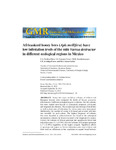
Please use this identifier to cite or link to this item:
http://ricaxcan.uaz.edu.mx/jspui/handle/20.500.11845/888Full metadata record
| DC Field | Value | Language |
|---|---|---|
| dc.contributor | 111167 | es_ES |
| dc.creator | Medina Flores, Carlos Aurelio | - |
| dc.creator | Guzmán Novoa, Ernesto | - |
| dc.creator | Hamiduzzaman, Mollah | - |
| dc.creator | Aréchiga Flores, Carlos Fernando | - |
| dc.creator | López Carlos, Marco Antonio | - |
| dc.date.accessioned | 2019-03-28T16:17:25Z | - |
| dc.date.available | 2019-03-28T16:17:25Z | - |
| dc.date.issued | 2014-02-21 | - |
| dc.identifier | info:eu-repo/semantics/publishedVersion | es_ES |
| dc.identifier.issn | 1676-5680 | es_ES |
| dc.identifier.uri | http://localhost/xmlui/handle/20.500.11845/888 | - |
| dc.description.abstract | Honey bee (Apis mellifera) colonies of African and European descent were compared for levels of Varroa destructor infestation in 3 different ecological regions in Mexico. The 300 colonies that were studied were located in subtropical, temperate sub-humid, and temperate dry climates. The morphotype and mitotype of adult bees as well as their rates of infestation by varroa mites were determined. Additionally, the number of combs with brood and covered with bees was recorded for each colony. The highest frequency of colonies that were classified as African-derived was found in the subtropical environment, whereas the lowest occurred in the temperate dry region. Overall, the colonies of African genotype had significantly lower mite infestation rates (3.5 ± 0.34%) than the colonies of European genotype (4.7 ± 0.49%) regardless of the region sampled. Significant effects of genotype and region on Varroa infestation rates were evident, and there were no differences in bee population or capped brood betweengenotypes. Mite infestation levels were significantly lower in the colonies of the temperate dry region than in the colonies of the other 2 regions. These results are discussed within the context of results from studies that were previously conducted in Brazil. This is the first study that demonstrates the effects of Africanization and ecological environment on V. destructor infestation rates in honey bee colonies in North America. | es_ES |
| dc.language.iso | spa | es_ES |
| dc.publisher | FUNPEC-RP | es_ES |
| dc.relation.ispartof | http://dx.doi.org/10.4238/2014.February.21.10 | es_ES |
| dc.relation.uri | generalPublic | es_ES |
| dc.rights | Atribución-NoComercial-CompartirIgual 3.0 Estados Unidos de América | * |
| dc.rights.uri | http://creativecommons.org/licenses/by-nc-sa/3.0/us/ | * |
| dc.source | Genetics and Molecular Research, Vol. 13, No. 3, 2014, 7282-7293 | es_ES |
| dc.subject.classification | CIENCIAS AGROPECUARIAS Y BIOTECNOLOGIA [6] | es_ES |
| dc.subject.other | Apis mellifera | es_ES |
| dc.subject.other | Africanized bees | es_ES |
| dc.subject.other | Varroa destructor | es_ES |
| dc.subject.other | Varroa resistance | es_ES |
| dc.subject.other | Environmental effects | es_ES |
| dc.subject.other | Mexico | es_ES |
| dc.title | Africanized honey bees (Apis mellifera) have low infestation levels of the mite Varroa destructor in different ecological regions in Mexico | es_ES |
| dc.type | info:eu-repo/semantics/article | es_ES |
| Appears in Collections: | *Documentos Académicos*-- UA Veterinaría | |
Files in This Item:
| File | Description | Size | Format | |
|---|---|---|---|---|
| Medina-Flores-etal-2014-GMR.pdf | 907,01 kB | Adobe PDF |  View/Open |
This item is licensed under a Creative Commons License
